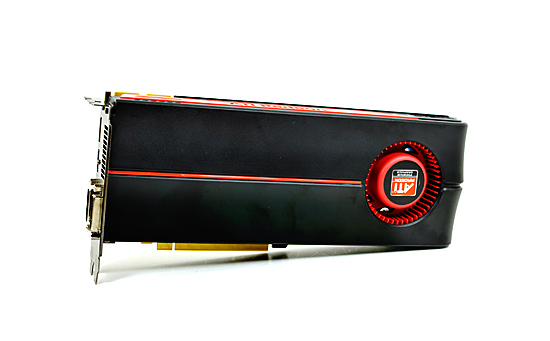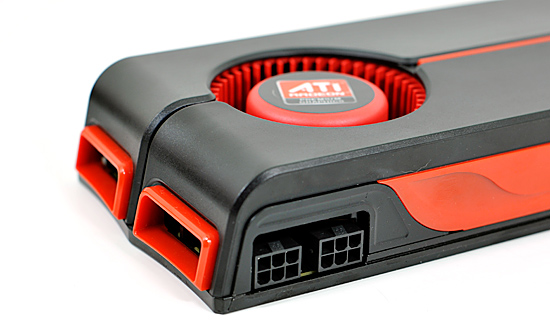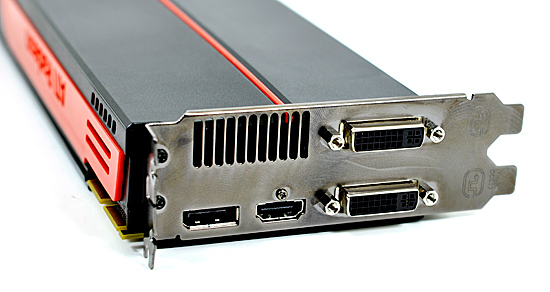AMD's Radeon HD 5870: Bringing About the Next Generation Of GPUs
by Ryan Smith on September 23, 2009 9:00 AM EST- Posted in
- GPUs
Meet the 5870
The card we’re looking at today is the Radeon HD 5870, based on the Cypress core.

Compared to the Radeon HD 4870, the 5870 has seen some changes to the board design. AMD has now moved to using a full sheath on their cards (including a backplate), very much like the ones that NVIDIA has been using since the 9800GTX. The card measures 10.5” long, an inch longer than the 4890 or the same as the 4870x2 and the NVIDIA GTX lineup.
The change in length means that AMD has moved the PCIe power connectors to the top of the card facing upwards, as there’s no longer enough room in the rear. Facing upwards is also a change from the 4870x2, which had them facing the front of the card. This, in our opinion, makes it easier to plug and unplug the PCIe power connectors, since it’s now possible to see what you’re doing.
Since the card has a TDP of 188W, AMD can still get away with using two 6-pin connectors. This is going to be good news for those of you with older power supplies that don’t feature 8-pin connectors, as previously the fastest cards without 8-pin connectors were the 4890 and GTX 285.

Briefly, the 5850 that we are not testing today will be slightly smaller than the 5870, coming in at 9.5”. It keeps the same cooler design, however the PCIe power connectors are back on the rear of the card.
With the 5800 series, DisplayPort is getting a much-needed kick in the pants. DisplayPort (full size) is standard on all 5800 series cards – prior to this it has been rather absent on reference cards. Along with a DisplayPort, the 5870 reference card contains a dedicated HDMI port, and a pair of DVI ports.
Making 4 ports fit on a card isn’t a trivial task, and AMD has taken an interesting direction in making it happen. Rather than putting every port on the same slot of the bracket as the card itself, one of the DVI ports is raised on to the other bracket. ATI could have just as easily only equipped these cards with 1 DVI port, and used an HDMI-to-DVI adapter for the second port. The advantage of going this direction is that the 5800 series can still drive two VGA monitors when using DVI-to-VGA adapters, and at the same time having an HDMI port built in means that no special adapters are necessary to get an HDMI port with audio capabilities. The only catch to this specific port layout is that the card still only has enough TMDS transmitters for two ports. So you can use 2x DVI or 1x DVI + HDMI, but not 2x DVI + HDMI. For 3 DVI-derived ports, you will need an active DisplayPort-to-DVI adapter.
With the configuration AMD is using, fitting that second DVI port also means that the exhaust vent of the 5800 series cards is not the full length of the card as is usually common, rather it’s a hair over half the length. The smaller size had us concerned about the 5870’s cooling capabilities, but as you’ll see with our temperature data, even with the smaller exhaust vent the load temperatures are no different than the 4870 or 4850, at 89C. And this is in spite of the fact that the 5870 is rated 28W more than the 4870.

With all of these changes also comes some changes to the loudness of the 5870 as compared to the 4870. The 27W idle power load means that AMD can reduce the speed of the fan some, and they say that the fan they’re using now is less noticeable (but not necessarily quieter) than what was on the 4870. In our objective testing the 5870 was no quieter than any of the 4800 series cards when it comes to idling at 46.6dB, and indeed it’s louder than any of those cards at 64dB at load. But in our subjective testing it has less of a whine. If you go by the objective data, this is a push at idle and louder at load.
Speaking of whining, we’re glad to report that the samples we received do not have the characteristic VRM whine/singing that has plagued many last-generation video cards. Most of our GTX cards and roughly half of our 4800 series cards generated this noise under certain circumstances, but the 5870 does not.
Finally, let’s talk about memory. Despite of doubling just about everything compared to RV770, Cypress and the 5800 series cards did not double their memory bandwidth. Moving from the 4870 and it’s 900MHz base memory clock, the 5870 only jumps up by 33% to 1.2Ghz, in effect increasing the ratio of GPU compute elements to memory bandwidth.
When looking back at the RV770, AMD believes that they were not bandwidth starved on the cards that used GDDR5. And since they had more bandwidth than they needed, it was not necessary to go for significantly more bandwidth for Cypress. This isn’t something we can easily test, but in our benchmarks the 5870 never doubles the performance of the 4870, in spite of being nearly twice the card. Graphics processing is embarrassingly parallel, but that doesn’t mean it perfectly scales. The different may be a product of that or a product of the lack of scaling in memory bandwidth, we can’t tell. What’s for certain however is that we don’t have any hard-capped memory bandwidth limited situations, the 5870 always outscores the 4870 by a great deal more than 33%.










327 Comments
View All Comments
ilnot1 - Wednesday, September 23, 2009 - link
In fact, going by the lowest Newegg prices, this is how the top setups would stack up today:5870 CF .......= $760
GTX 285 SLI .= $592
GTX 295 .......= $470
GTX 275 SLI .= $420
5870 ............= $380
4890 CF ........= $360
4870 X2 ........= $330
This would make the 4890 CF or the 275 SLI setups the best value. And yes I realize there will be availability issues and price adjustments over the next month or so.
DominionSeraph - Thursday, September 24, 2009 - link
you forgot:4870 CF: $260-280
and how about the $180 4850 CF, which is probably the best price/performance for sub-1920x1200 gaming. http://www.anandtech.com/video/showdoc.aspx?i=3517...">http://www.anandtech.com/video/showdoc.aspx?i=3517... You can even get 1GB versions for ~$190.
ilnot1 - Wednesday, September 23, 2009 - link
Another very good review, thanks.But piggy backing on what wicko said, I'm surprised you didn't include two 4890 in CF. Seeing as how you can get two 4890 for less than a 5870 (whenever they are actually available). $180 x 2 = $360 < $379. And this from Newegg, not some super special sale price.
http://www.newegg.com/Product/Product.aspx?Item=N8...">http://www.newegg.com/Product/Product.aspx?Item=N8...
Ryan Smith - Wednesday, September 23, 2009 - link
It's something we would have included if we had the cards. I don't have 2 4890s, and we couldn't get a second one in time.AnotherGuy - Wednesday, September 23, 2009 - link
as always anandtech roxnbjsl2000 - Wednesday, September 23, 2009 - link
Finally time to upgrade..SiliconDoc - Wednesday, September 23, 2009 - link
Not only all that, but when there were 13 big titles for PhysX and a hundred smaller ones, we were told here, "Meh", who needs it.Now, we have a papery and unavailable (egg)except by pre-order(tiger) 5870 launch, a not-existing 5850, with guess what ? NO DX11 games!
Oh wait, there is actually just ONE - see page 7 of review. LOL
---
Conclusion ?: " It looks like NO(err.. just one) DX11 games ready, so... it also looks like NVidia is launching at the right time, and ATI blew their dry unimpressive wad on a piece of paper porn. "
---
Gee no one crowing about the first DX11 card... imagine that...
Good thing , too, considering how 13 big or a hundred titles small of PhysX enhanced games was "nothing to change one's purchase decision over". At least Anand got addicted to Mirror's Edge with PhysX enabled before concluding in the article "meh" this PhysX thing is ok if you like this game, but who cares...
---
Now we have the DX11 pre DX11 games launch with a paper product, so crowing about it wouldn't be too fitting, huh.
monomer - Wednesday, September 23, 2009 - link
Why would a developer would release a DX11 game before DX11 is even available?SiliconDoc - Friday, September 25, 2009 - link
Why would a developer release a DX11 card before DX11 is even available ?(I suppose you'll have to unscrew your hate nvidia foil cap, and grind in the red spikes in it's place to answer that one.)
However, allow me, instead.
1.I have been running windows 7 32&64 for quite some time now, not sure why you haven't been.
2. Battleforge, an ATI promo game, as noted in the review, has released their DX11 patch, hence, with W7 from MSFT (the beta+ free trial good till March 1st 2010 or something like that) I believe any gamer has had a reasonable chance to preview DX11.
---
So anyway...
cactusdog - Friday, September 25, 2009 - link
Ya , ATI has done it again. Excellent performance for a fair price. If Nvidia released this exact card it would be $150-$200 more expensive.LOL, Nvidia sales are gonna be slow for a while.